#Zoom Stereo Microscope
Explore tagged Tumblr posts
Text
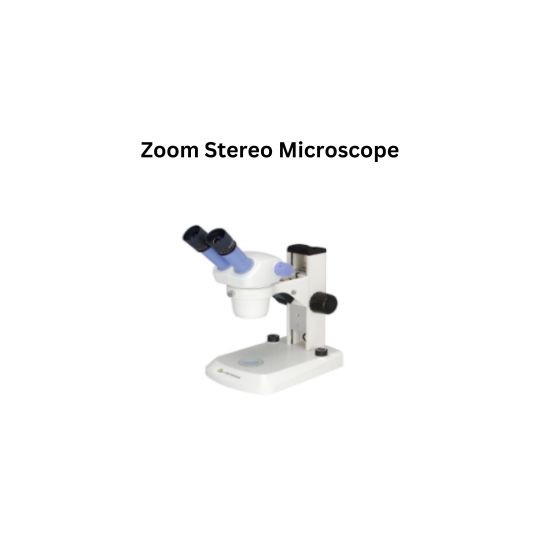
Zoom stereo microscope
Zoom stereo microscope is a dissecting microscope featuring a low magnification range. This bench-top unit on a post stand provides very clear upright, un-reversed 3-D image throughout the zoom range. Coarse focus knob with tension adjustment aids in mobility of the objective lenses. Magnification range and working distance can be expanded using optional eyepieces and auxiliary objectives.
#zoom stereo microscope#trinocular stereo zoom microscope#leica stereo zoom microscope#olympus stereo zoom microscope#stereo zoom microscope with camera
0 notes
Text
Microscope Manufacturers & Suppliers in India
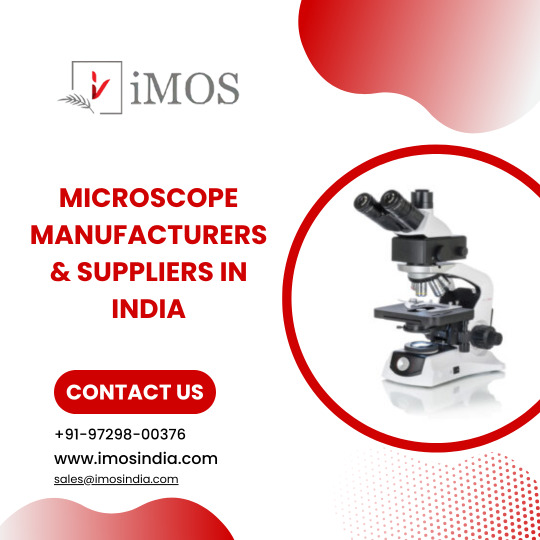
Many microscope manufacturers and suppliers worldwide offer different kinds of quality optical, digital, and electron microscopes for educational, medical, and industrial purposes. Due to the state of the art technology and advanced precision manufacturing capabilities the manufacturers put great emphasis on quality imaging and durability. They are trusted all over the world and are committed to customer service, product quality, price, and customized solutions for all laboratory and research purposes. Experienced top quality microscope solutions with Infinity Optics - leading manufacturers and suppliers of microscopes in India. The motors driving Infinity Optics is precision, reliability, and innovation, so please go ahead and experience the advanced optical instruments offered by Infinity Optics.
#Inverted microscope#Fluorescent Microscope#Microscope Manufacturers in India#Microscope Suppliers#Laboratory Microscope Suppliers#Microscope Manufacturer in Ambala#Laboratory Equipment Manufacturers in India#Lab Equipment Suppliers in India#Stereo Zoom Microscope Supplier#Multi View Microscope#Upright Fluorescent Microscope#Research Microscope#Microscope Manufacturers & Suppliers in India
2 notes
·
View notes
Text
Digital Microscope is a type of microscope that uses optics and a digital camera to output an image to a screen often through software running on a computer. Digital Microscope differs from traditional microscopes by their ability to capture images and videos, often at high resolutions, for documentation or analysis purposes. They are becoming increasingly popular in various fields, including biology, metallurgy and electronics.

0 notes
Text
Stereo Zoom Microscope -HSM-800-Series
Stereo zoom microscope, also known as a stereomicroscope or dissecting microscope, is a type of optical microscope designed for three-dimensional (3D) observation of objects at low to moderate magnification levels. Unlike compound microscopes, which are typically used for high-magnification and two-dimensional observations of thin, transparent specimens, stereo zoom microscopes are designed for studying solid, opaque, or thick specimens in 3D. Being a highly effective, lean and fast-moving organization, we are highly instrumental in providing Zoom Microscope. It is a kind of binocular or trinocular stereo microscope, which can magnify micro-objects continually and show upright images. These microscopes are accessible in numerous specifications as per the variegated demand of customers. we offer these microscopes after examining them properly on numerous parameters. Stereo Zoom Microscope is a kind of binocular or trinocular stereo microscope, which can magnify micro-objects continually and show upright images. These microscopes are accessible in numerous specifications as per the variegated demand of customers. we offer these microscopes after examining them properly on numerous parameters.
microscopes, stereo microscopes, zoom microscopes, stereo zoom microscopes, optical microscopes, binocular microscopes, trinocular microscopes, trinocular stereo microscopes
#manufacture#industrial equipment#manufacturer#metallurgical#metallographicequipments#metallurgicalmicroscopes#microscope#microscopes#stereo microscopes#zoom microscopes#stereo zoom microscopes#optical microscopes#binocular microscopes#trinocular microscopes#trinocular stereo microscopes
1 note
·
View note
Text



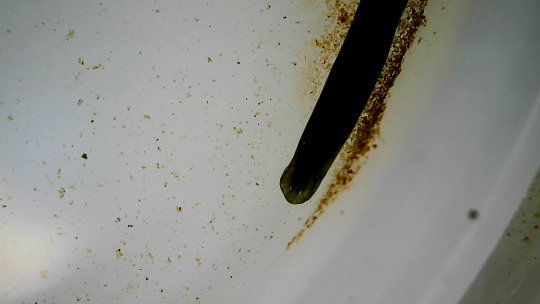

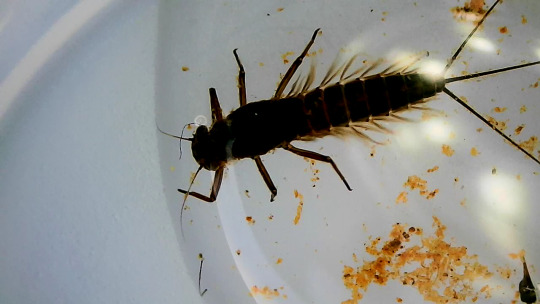

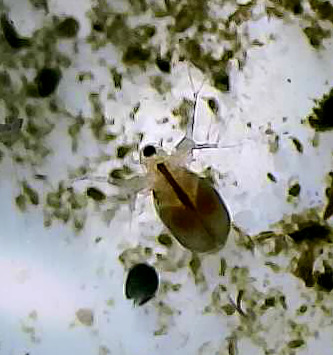
So my newest obsession is taking samples from waterways/ponds and looking at them under my microscope. I need a compound microscope ASAP, right now I just have a kind of field/stereo microscope, and the images get really crappy when zoomed in.
So anyway, feel free to go to my iNat and ID my shit?
3 notes
·
View notes
Photo

This is a bee leg captured under the stereo microscope.
11 notes
·
View notes
Text
I wonder if there are more of these, I've been fascinated by these pictures from when I first saw them, like, a billion years ago.
If I could afford it, I would do so much micro-photography, maybe not as zoomed in as these, but definitely with my rock collection, because then I could get rid of a whole bunch of rocks lol.
On a random note, I helped out with a university summer science week for senior high school students during the main school holidays back home in AoNZ, with the geology department. One of the activities we did with kids was to collect a sandstone rock from the peninsula up the coast, bring it back, do the whole 'extract the fossil plankton (like, foraminifera or ostracods, etc.) from the rock and then set the kids to 'picking' the micro-fossils from the results. The kids were so happy just spending an hour or two randomly picking tiny fossils of this processed rock mix, and I remember being much the same during my geology undergrad. I mean, I was shite at the technical stuff, and identifying anything (I literally would rather dig up fossils and prep them, than figuring out all the science around them lol), because hyper-fixating, but it was fascinating and somewhat relaxing!
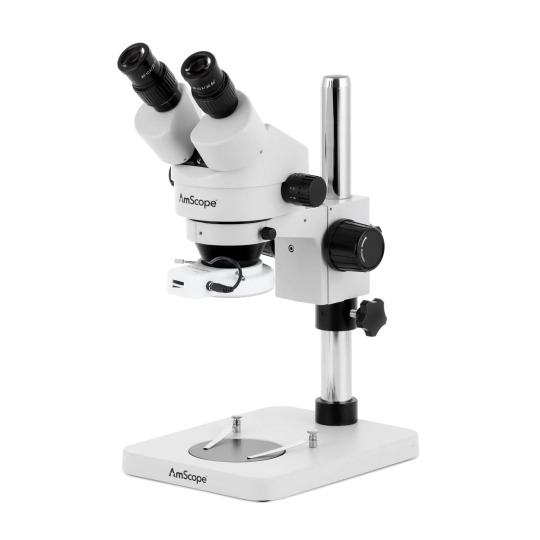
I'm a binocular/stereo microscope! I'm what you use to scout out your 'picks'. I'm going to give you headache after headache when you hyper-fixate on 'picking' microfossils...

After you've smashed up your rock, and boiled it, effectively 'disaggregating' (pulling the rock apart, like, a lot) with dish soap and some other chemical I can't remember, you're left with something similar to this. Oh, and you have to dry it out first, like, under heat lamps.
Then, spread a bit of the fossil/rock remnant mix onto a tray, like below (though, we had round ones that for the life of my I cannot find a picture of on the net #lesigh),

and using a super-fine paintbrush, (and sometimes we'd also use wooden dowels that had small metal poles with a rounded tip put into them - DIY Kiwi-style, yo...) sort through your mix.
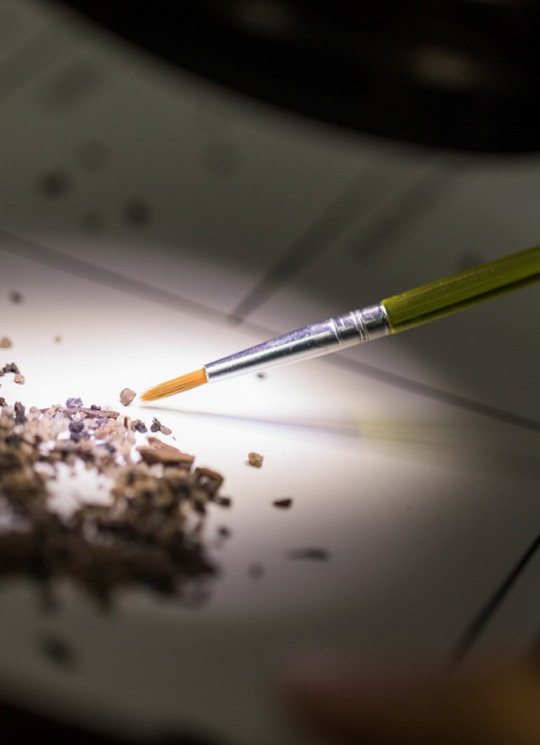
Once you've found/isolated a likely specimen that isn't just a piece of fancy sand, or shell piece, or fish bone (though you can add these to your tray if you want), and you've remembered to moisten the paintbrush tip, either with water or handy-dandy saliva from your very own mouth (you would not believe how much time this saves, though no sharing paintbrushes in these disease-ridden times), you can use said moistened brush to pick up your target and add it to your super-special micro-fossil slide!
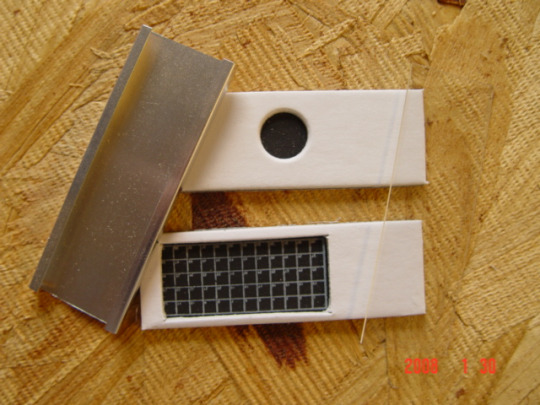
Above is an unused tray that has been pulled apart (ignore the slide with the circle, the grid one is where we are at). To put it back together once you're done 'picking', the glass slide goes overtop the cardboard 'grid' slide, and then they both slide into the metal tray. One would generally place groups of similar 'tests' (or shells) in the same grid number to identify later (or at the same time if you had mad skills).

We'd sometimes use a bit of green dye (and no, we didn't put the green dye in our mouths first...) to stain the tiny shells to help make identification easier.

Of course you ask what is the actual point of all this, other than a delightful, sometimes headache-inducing, way to pass a few hours in an activity that should be rather boring? Well. I'm going to tap into my memory and hope like hell that I recall this shite correctly. The main reason is being able to use these wee buggers to link a layer (or layers) of rock in different areas, because if you've got a couple of microfossils in one area, and the same types in another area, you can be all 'check-out-the-correlating-rocks-yo'. Or something. This is called biostratigraphy. It's especially useful if one rock layer is near a datable-by-isotype-type-rock like lava rocks, because then you can extrapolate that shite everywhere, and voila! Dateable rocks! And organised rocks!

Species change though time because of that pesky evolution thing, or completely unsubscribe from life, and can be linked to age ranges (like an upper and a lower limit from when they are first found and when they are last found in a rock) in the geological time scale. Of course, the geological timescale lives to confuse, and add in localised time periods that link to localised rock formation names (I'll explain later #lesighpartdeux) that somehow tie into the epochs and eras and before long:

BUT THAT'S NOT ALL! Micro-palaeontology (or micro-pal, for those of us cool geology kids) is used extensively in the oil/gas exploration industry, for better or worse, well, worse really, but yeah, via the whole biostratigraphy schtick (they drill a core (like, a long shaft of rock) and then figure out the rock types and use microfossils to date and correlate, and then use it when they are already in an oil 'field' to check where the right rocks are, because it's not normally flat layers of rocks awaiting exploitation. It's more like a jumbled up jigsaw puzzle with some parts of the same rock up, some down, some folded/squashed together, some starting to get a little baked, and some eroded away long before the rest of the rocks were buried. Fun stuff all around!):

(I spent far too long in Publisher making this stupid representative graphic and I can already see things I've missed out *LABELS ANYONE???* but oh well...) but also there's this thing called palaeoecology AND also also palaeoclimatology that are super useful for establishing past climates and environments, which I'll go into later because this is getting stupid long and my brain is fried and needs sleep but I've got one last thing that I want to mention that may be one of the greatest things ever about geology and palaeontology and micro-pal and so on and so forth.
!!!!!OTOLITHS!!!!

WHAT ARE OTOLITHS, I HEAR YOU ASK?????
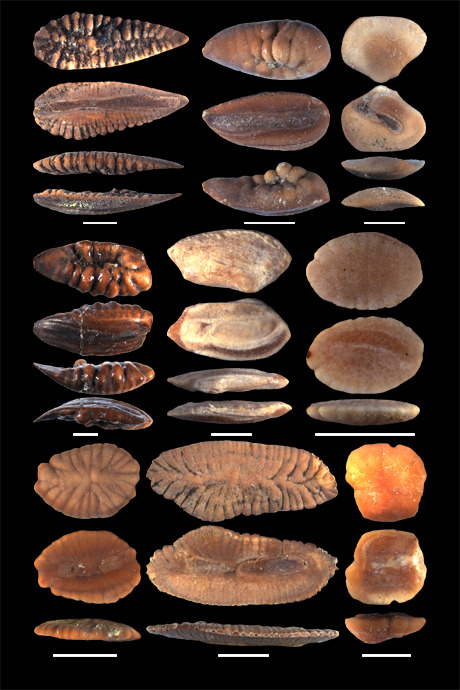
Fossilised fish ears! Who would have thought? I didn't even really think fish could hear underwater, which I believe such dimness is called BEING A MUPPET in my culture...

But it's true! I remember being so so so so so confused when I was picking forams for some geology lab and there were these funny shaped things in my rock mix. And they have such a variety of shapes.
And that's all for now, must sleep, will prolly revise this since it's prolly a load of crap geoscicomm but I'll get there! Happy micro-paling!

when i die i hope i come back as a beautiful microscopic granule of sand
#microfossils#micropalaeontology#palaeontolgy#binocs#foraminifera#forams#geoscicomm#geology#picking#super special micropal slides#Oh I forgot pollen#maybe next time#ooo do you know what a phytolith is?#if I've spelt it correctly lol#FISH HAVE EARS#terrible graphics#palaeoecology#palaeoclimatology#not that there's much about them#also next time#It's over!!!!
76K notes
·
View notes
Text
0 notes
Text
0 notes
Text

Fluorescent stereo microscope
Fluorescent stereo microscope cover a wide magnification range from 2.4X ~ 480X. It allows the scientist to see and photograph specimens from macro views to high-magnification micro visualization. Additional photo tube comes with the microscope, CCD camera can be mounted on the photo tube for image capture and analysis.
#leica stereomicroscope#amscope stereo microscope#stereo zoom microscope#leica dissecting microscope#olympus stereo microscope#dissecting scope#zeiss stereo microscope
0 notes
Text
6 Different Types of Microscopes and Their Uses Explained
Written by Microscope Hunt Authority

Get ready to dive into the unique world of microscopes. It is a special device that increases the size of small objects to see them better. Microscopes have been integrated into schools, research labs, hospitals, and even homes by people who are curious about the unseen world that lies within and around us. This device helps us view objects and organisms that cannot be viewed by the eye such as blood, bacteria, and many more. In this write-up, we are going to discuss the types of microscopes and their functions in the most basic way so that we don’t lose our intended audience, be it students, teachers, professionals, or any biology buff who would relish learning about biology.
What is a Microscope
As stated above, microscopes enhance the view available of an object to give its details. They use lenses to increase the size of small items such as cells, and even tiny bugs. As with most devices, microscopes have uses in science and medicine as well, in fact they are relied on heavily. Psychiatrists require having the best equipment to ensure diseases are detected in a timely manner and scientists require studying organisms. Students studying for their biology class need reliable equipment for understanding the concepts that are being taught. Knowing how to differentiate the varying types of microscopes makes it easier to select the equipment considering the purpose they want to serve.
Compound Microscope

The most common one is an optical microscope; it uses visible light and a few lenses to magnify the sample. This microscope often grazes through the classroom and biology lab. It is well-suited for observing thin sections of plant and animal cells as well as bacteria. A compound microscope can make things look much bigger, usually between 40 times and 1000 times their actual size.. Less complicated, cost-effective, and perfect for educational and simple purposes are their characteristics.
Stereo Microscope

Stereo microscopes can be used to view objects in three dimensions. It has two eyepieces and shines light from above to help you see the sample clearly. Solid objects such as insects, flowers, coins, or small mechanical parts should be viewed under a dissecting microscope. It has a lower magnification power, between 10x and 100x. Professionals, students, and hobbyists who need a three-dimensional view will find it useful.
Digital Microscope

A digital microscope connects to a monitor or computer and shows the zoomed-in image right on the screen. You view the image on a monitor rather than through eyepieces. Some digital microscopes let you record videos and photographs of what you observe. They are handy for sending photos, presentations, and classroom instruction. Schools, hobbyists, and offices requiring documentation use digital microscopes.
Electron Microscope

To magnify objects, an electron microscope uses electrons rather than light. At a far greater magnification than light microscopes, it can reveal minute features. The two primary kinds are:
Scanning Electron Microscope (SEM): shows a three-dimensional view of the sample’s surface, helping you see its details and texture.
Transmission Electron Microscope (TEM): Shows the interior details of a very thin sample.
Research laboratories and businesses use these microscopes. Magnifying things to millions of times, they expose atomic level detail. Scientists and engineers mostly use them.
Fluorescence Microscope

Special lights and dyes in this microscope cause sample components to shine. Often, scientists use it to view particular cell or tissue components. It aids in locating the sites of particular chemicals or proteins. Common in cell biology and medical research are fluorescence microscopes. They help doctors understand diseases better and develop treatments.
Confocal Microscope

The confocal microscope is a sophisticated version of the fluorescence microscope. It employs lasers to scan samples and construct clear, sharp images. Scanning in various depths, it can construct 3D images of the sample. It is extremely useful for examining thick samples or acquiring detailed views of cells and tissues. Confocal microscopes are extensively used in advanced biology and medical laboratories.
Comparison of Microscopes
Here’s a simple comparison to help understand the different types of microscopes and their uses:
.Microscope TypeMagnificationView TypeBest ForUsed InCompound Microscope40x – 1000x2DCells, bacteriaSchools, general labsStereo Microscope10x – 100x3DSolid objects like insects, plantsDissection, electronics, hobbiesDigital MicroscopeVaries2D/MonitorImages/videos of small objectsTeaching, sharing, documentationElectron MicroscopeUp to 10,000,000x3D (SEM), 2D (TEM)Surfaces, inside of samplesResearch labs, industryFluorescence Microscope200x – 2000xGlowing viewSpecific cell partsMedical and biological researchConfocal Microscope200x – 2000x3DDetailed 3D views of cellsAdvanced research labs
Each type of microscope is useful for different things. That’s why it’s important to learn about the different types of microscopes and their uses before buying or using one.
Who Uses Microscopes
Students learn more about science using light and stereo microscopes.
Doctors diagnose issues in blood and tissue samples using microscopes.
Cell, viruses and other materials are studied by scientists with more advanced tools such as electron and confocal microscopes.
Tiny portions of stamps, bugs and other stuff are examined by hobbyists using stereo and digital microscopes.
Regardless of the reason functioning with microscopes, one has to understand the scope options to choose which is most suitable and handy.
Final Thoughts
Every item we encounter daily, from the light microscope to the powerful electron microscope, has a world inside waiting to be discovered. Living things and items we cannot see with the naked eye can be viewed through microscopes, and learning all the microscopes and their features allows us to have powerful discoveries. No matter if you are learning, working, or just exploring, the appropriate microscope will extend your tiny territory.
0 notes
Text
What Are the Best Practices for Microscope Safety?
Microscopes are crucial instruments that enable scientists, students, and healthcare providers to see things that are not visible to the naked eye. These tools have various types including compound microscopes, stereo microscopes, digital microscopes, and inverted microscopes. Being sensitive tools, specialized care is necessary for using, maintaining and storing them so that correct measurements are recorded, they last long, and the operators are not exposed to any risk. A reliable microscope manufacturer and supplier in China supplies quality microscopes for laboratories, schools, and medical institutions. In this blog, we will focus on the safety protocols required while using microscopes, and the different types of microscopes.
6 Best Practices For Microscope Safety
For a microscope to be used stably and for a long time, safety and proper maintenance are of utmost importance. There are six ways to enhance the use of microscopes:
Use Proper Handling Methods
Microscopes are sensitive devices that should be treated with care. To avoid accidents that could potentially damage their optical components, always support the base and hold on to the arm while carrying them.
Always Clean the Workspace
Make use of the microscope on a surface that is clean, flat and has no clutter which will prevent the tipping of the microscope or having it knocked over by an accidental fall. Ensure the working area does not contain any fluids or things that are likely to float around and interfere with the use of the equipment.
Utilize Proper Cleaning Methods
The preservation of clarity of view in a microscope is very important. If the contact surface becomes dirty, first try to wipe it with lens paper or optical microfibre cloth. Avoid directly touching lens surfaces should be avoided; otherwise, skin oils or debris may smear the glass. In case of persistent marks, use a commercially available cleaning solvent.
Lighting Should Be Adjusted with Caution
The lighting control is very important for observing specimens. Never work under tremendous bright light that could either endanger the microscope or cause stress on the user's eyes. The LED lights in digital and compound microscopes that have been built into the handle should be used prudently.
Microscope Covers
While operating the microscope, it is important to cover the microscope with a dust cover when it is not in use. Failure to cover the microscope will lead to dust particles settling on the lenses and mechanical parts causing failure or total loss of image sharpness.
Refrain From Over Adjusting Tightening
The focus knobs or stage control which have been over-tightened can break the mechanisms inside the microscope. Microscopes and their delicate internal engineering rarely can be adjusted roughly, so they should be tuned with extreme caution. Finally, always use and care for the microscope as prescribed by the manufacturer's instructions.
Essential Microscope Types
Numerous types of microscopes are manufactured with certain applications in mind, making it necessary for you to select the model that best suits your requirements.
Compound Microscope
The compound microscope is a commonplace piece of equipment in the laboratories, being able to magnify specimens to as much as 1000x or more. It incorporates various lenses that zoom in on microscopic and semi-transparent specimens, meaning cells or bacteria. Its adaptability has made it a standard in biology and medical laboratories.
Stereo Microscope
A stereo microscope sometimes called a dissecting microscope, allows the user to see a larger specimen in three dimensions. In electronics and botany, it is used extensively for activities that require observing the features and structures of surfaces from a closer distance.
Digital Microscope
The incorporation of advanced optics into digital imaging technology has resulted in the ability to capture and analyze images, making digital microscopes a reality. Since these are suited for displays, documentation of research, or educational activities.
According to Wikipedia, A digital microscope is an adaptation of a conventional optical microscope that outputs an image to a monitor using optics and a digital camera, occasionally with the help of computer software. Unlike an optical microscope, which allows direct observation of the sample through an eyepiece, a digital microscope frequently has its own built-in LED light source.
Inverted Microscope
The inverted or reversed set-up are inversely operated microscopes that allow for surface observation of cultured cells. In principle, from any objective view, placing its center stage and pan, light, and a focusing device (condenser) on the upper stage, as opposed to the plane of the specimen.
Fluorescence Microscope
This advanced microscope uses the phenomenon of fluorescence, making it useful in the detection of specific elements within the cells. These can be proteins, nucleotides and so on. It has found a broad application in cell biology and medicine diagnostics.
Why Choose Edu Lab China?
Edu Lab China is the best microscope manufacturer and supplier in China for a number of reasons. The zeal for innovations, quality, and customer satisfaction ensures that each product produced is by international standards. The company has compound, stereo, and digital microscopes thus serving various industries as well as educational centers.
A major strength of Edu Lab China is quality, reliability, and accuracy which enables institutions, laboratories, and research centers all over the world to acquire them. In addition, the company has strong after-sales service and support which includes technical support enabling clients to maximize their investment.
Conclusion
Microscopes are indeed important equipment in examining working quantitatively on the microscopic world, although they require proper handling and careful operation. Adhering to the best practices mentioned above helps to ensure that the microscope serves its intended purpose for many years without fail. However, regardless of whether you are in the market for a compound microscope, stereo microscope, or digital microscope, finding a trustworthy microscope manufacturer and supplier in China is very important. With their vast array of high-quality microscopes that are readily customizable, along with their high dedication to customer service and satisfaction, Edu Lab China is the best option to go for. Make the right decision and invest in the best to be confident in your research, educational, or industrial processes.
#physics laboratory equipment manufacturer in china#laboratory glassware manufacturer in China#mechanical engineering laboratory equipment suppliers in China#school laboratory equipment manufacturers in China#civil engineering laboratory equipment manufacturers in china#analytical lab equipment manufacturer and supplier#anatomical model manufacturer and supplier#astronomy lab equipment manufacturer and supplier#biology lab equipment manufacturer and supplier#chemical lab equipment manufacturer and supplier#chemistry lab equipment manufacturer and supplier#educational lab equipment manufacturer and supplier
0 notes
Text
youtube
0 notes
Text
hexagon cmm malaysia
Precision Measurement Tools Revolutionizing Malaysian Industries – From Digital Microscopes to Trimos Height Gauges
In today’s fast-paced industrial and manufacturing world, accuracy and efficiency are more critical than ever. Whether you're in automotive, aerospace, medical, or electronics manufacturing, ensuring the quality and precision of your components is key to maintaining competitiveness. This is where Takumiprecision.com.my steps in—your trusted partner in precision tools across Malaysia.
From digital microscopes and stereo microscopes to Trimos height gauges and Hexagon CMMs, Malaysian industries now have access to world-class measuring solutions that enhance productivity, quality, and reliability.
The Rise of Digital Microscope Technology in Malaysia
The evolution of microscopy has led to the advent of the digital microscope malaysia, a powerful tool that combines high-resolution imaging with advanced software to analyze the finest details of materials and components. In Malaysia, digital microscopes are gaining immense popularity due to their wide application across industries like electronics, metallurgy, and research labs.
Digital microscopes in Malaysia allow users to view, capture, and analyze images with ease. The benefits include:
High-definition live imaging
Real-time measurements
Documentation and reporting capabilities
Minimal operator training
Whether you are performing circuit board inspections or failure analysis, a digital microscope in Malaysia offers unmatched clarity and functionality, making it a must-have tool for precision-driven businesses.
Why Stereo Microscopes Still Matter in Modern Manufacturing
Despite the rise of digital alternatives, the stereo microscope remains an essential instrument for many hands-on tasks. These microscopes provide a three-dimensional view of a sample, offering depth perception that is especially useful in applications like soldering, dissection, and intricate assembly work.
At Takumiprecision.com.my, we offer stereo microscope Malaysia solutions that deliver clear optics, adjustable zoom levels, and ergonomic design. Our stereo microscopes are ideal for:
PCB inspection and rework
Biological dissection
Jewelry and watch repair
Quality control processes
In Malaysia, stereo microscopes are commonly used in educational institutions and industrial labs where close-up visual inspection is crucial.
Trimos Malaysia – Swiss Precision Meets Malaysian Innovation
Trimos is a globally renowned Swiss manufacturer known for its superior dimensional measuring instruments. As an authorized distributor of Trimos Malaysia, Takumiprecision.com.my brings you access to this world-class brand, ensuring you can measure with the utmost confidence and precision.
Trimos products are engineered for reliability and ease of use. Among the most popular Trimos products in Malaysia are:
Horizontal measuring instruments
Surface measuring systems
Roundness and form testers
What sets Trimos apart is its focus on innovation, user-friendly interfaces, and long-lasting precision. For manufacturers in Malaysia seeking dependable Swiss technology, Trimos Malaysia is the benchmark.
The Power of Trimos Height Gauge in Quality Control
A standout product in the Trimos line-up is the Trimos Height Gauge, a fundamental tool in every quality control lab. These gauges are designed for accurate vertical measurements, and they often serve as the reference standard for measuring the height, depth, and internal/external diameters of components.
At Takumiprecision.com.my, we offer a variety of Trimos height gauge models that are:
Digitally operated with touchscreen displays
Capable of storing measurement data
Built with Swiss precision for years of reliable service
The Trimos height gauge is indispensable in environments such as CNC workshops, inspection labs, and high-precision production lines across Malaysia. Its ergonomic design and intuitive interface make it ideal for both novice and experienced users.
Measuring to Microns with Hexagon CMM in Malaysia
When it comes to complex geometries and multi-axis parts, nothing beats the precision of a coordinate measuring machine (CMM). Among the leading CMM brands in the world is Hexagon, and we're proud to bring Hexagon CMM Malaysia solutions to our clients at Takumi Precision.
Hexagon CMM Malaysia systems deliver high-accuracy 3D measurement that is vital for:
Aerospace components
Medical device manufacturing
Mold and die inspection
Reverse engineering
These CMMs utilize touch-trigger and scanning probes, laser sensors, and automated systems to deliver data-rich analysis that supports smart manufacturing. Hexagon’s advanced software also enables real-time inspection and statistical process control, elevating the quality assurance game for manufacturers in Malaysia.
Why Choose Takumiprecision.com.my for Precision Equipment in Malaysia?
Takumiprecision.com.my is more than just a supplier—we are your strategic partner in quality assurance. We specialize in bringing the latest precision measurement tools to Malaysia, empowering industries to meet international standards and exceed client expectations.
Here’s why clients across Malaysia trust us:
Expert Consultation: We help you choose the right equipment for your specific application.
Certified Training & Support: Our team provides setup, training, and after-sales support to ensure smooth integration.
Latest Technology: We offer the newest models from globally respected brands like Trimos and Hexagon.
Local Presence: Being based in Malaysia, we understand local industry needs and deliver prompt, localized service.
Applications Across Diverse Industries
From semiconductor inspection with digital microscopes to dimensional validation with Hexagon CMMs, the equipment we provide serves a broad spectrum of industries:
Manufacturing and Machining
Electronics and Semiconductors
Aerospace and Automotive
Medical Device Manufacturing
Research and Education
Our goal is to help you enhance productivity, reduce rework, and deliver consistent quality—every time.
Conclusion
In the evolving world of industrial metrology and quality control, having the right tools makes all the difference. From digital microscopes Malaysia and stereo microscope Malaysia to world-class instruments like Trimos height gauges and Hexagon CMM Malaysia, Takumiprecision.com.my ensures you’re equipped for success.
0 notes
Text
Stereo Zoom Microscope -HSM Series
Stereo zoom microscope, also known as a stereomicroscope or dissecting microscope, is a type of optical microscope designed for three-dimensional (3D) observation of objects at low to moderate magnification levels. Unlike compound microscopes, which are typically used for high-magnification and two-dimensional observations of thin, transparent specimens, stereo zoom microscopes are designed for studying solid, opaque, or thick specimens in 3D. Stereo Zoom Microscopes provide Sharp stereo erect images over a wide field view. It has 45 0 inclined and 360 0 rotatable binocular head with a locked‐in eyepiece with diopter adjustment ±5 DP. The interpapillary distance can be adjusted between 55‐75mm.
#manufacture#industrial equipment#manufacturer#metallurgical#metallographicequipments#metallurgicalmicroscopes#microscope#microscopes#stereo microscopes#zoom microscopes#stereo zoom microscopes#optical microscopes#dissecting microscopes
1 note
·
View note